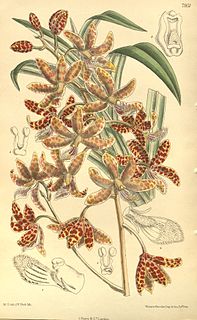Sankowskya is a genus of plants. The sole known species, Sankowskya stipularis, is a tree found only (endemic) in one locality in the Wet Tropics rainforests of north eastern Queensland, Australia. The species constitutes part of the plant family Picrodendraceae. Few botanical collections have ever been made of the trees, from a very restricted area of the Wet Tropics rainforests, hence the species has obtained the conservation status of "endangered" in the legislative regulation of the Queensland Government's Nature Conservation Act 1992. Notably, trees grow naturally in the Thylogale Nature Refuge.
Pilidiostigma is a genus of shrubs and small trees in the myrtle family Myrtaceae. All species occur in Australia and one, P. papuanum, also occurs in Papua New Guinea. They are not generally known to horticulture. The species P. sessile is rare.
Austromuellera is a genus of only two known species of medium-sized trees, constituting part of the plant family Proteaceae.
Myristica globosa is a species of plant in the Myristicaceae family. It is found in Papua New Guinea the Solomon Islands and Australia.
Beilschmiedia bancroftii is a tree species in the Lauraceae family. It is native to Queensland in Australia. Common names include yellow walnut, yellow nut and canary ash.

Hedraianthera is a genus of a sole recognised species of shrubs or small trees found only in Australia. The genus and species constitutes part of the plant family Celastraceae.
Tylophora benthamii, commonly known as coast tylophora, is a vine in the dogbane family. It was previously known as T. floribunda.

Mount Pieter Botte, also known as Ngalba-bulal, Alpaboolal, or Barbar is a mountain in the tableland region behind Cape Tribulation in Far North Queensland, Australia. It was named in 1848 by Captain Owen Stanley of the survey ship HMS Rattlesnake. The name was chosen by those on board the Rattlesnake. because of its resemblance to Peter Botte Mountain, a famous peak on the island of Mauritius. The mountain is part of the Wet Tropics of Queensland World Heritage Site.

Gymnostoma australianum, also named the Daintree pine or oak, is a species of small trees which are (endemic) to a restricted area of the Daintree tropical rainforests region, of the larger region of the Wet Tropics of north-eastern Queensland, Australia. They constitute part of the plant family Casuarinaceae, often named she-oaks, members of which are characterised by drooping equisetoid evergreen foliage, and separate male and female flowers (unisexual). Superficially they look like well known scale–leaved gymnosperm trees species, such as Cupressus in the northern hemisphere and Callitris in the southern hemisphere.

Carnarvonia is a flowering plant genus of a single species, commonly named red oak or red silky oak and constituting part of the plant family Proteaceae. The single species named Carnarvonia araliifolia grows to large trees of 30 m (100 ft) or more. They grow naturally only (endemic) in the Wet Tropics rainforests region of north-eastern Queensland, Australia. The species has two described varieties, C. araliifolia var. araliifolia and C. araliifolia var. montana, and the common names are used for both.

Eucryphia wilkiei is a species of rainforest shrubs growing naturally only (endemic) in restricted areas of cloud forests on mountain tops in the Wet Tropics region of north eastern Queensland, Australia. As of November 2013, botanists classify Eucryphia as constituting part of the plant family Cunoniaceae.
Helicia lewisensis is a species of rainforest trees, of north–eastern Queensland, Australia, and constitutes part of the flowering plant family Proteaceae.
Helicia grayi, also named Gray's silky oak, is a species of rainforest trees, of north–eastern Queensland, Australia, and constitutes part of the flowering plant family Proteaceae.
Helicia lamingtoniana, also named Lamington's silky oak, is a species of rainforest trees, of north–eastern Queensland, Australia, and constitutes part of the flowering plant family Proteaceae.
Hollandaea sayeriana, sometimes named Sayer's silky oak, is a species of Australian rainforest small trees, constituting part of the plant family Proteaceae.
Hollandaea riparia, sometimes named Roaring Meg Hollandaea, is a species of Australian rainforest small trees, constituting part of the plant family Proteaceae.
Hollandaea diabolica is a species of Australian rainforest trees, constituting part of the plant family Proteaceae.
Hollandaea porphyrocarpa is a species of Australian rainforest small trees, constituting part of the plant family Proteaceae.
Peripentadenia is a genus of two species known to science, of large trees found only (endemic) in the rainforests of north-eastern Queensland, Australia and constituting part of the plant family Elaeocarpaceae. Sometimes they have the common name quandong.

Dipodium pictum, commonly known as brittle climbing-orchid or climbing hyacinth-orchid, is an orchid species that is native to Malesia and the Cape York Peninsula in Australia.









